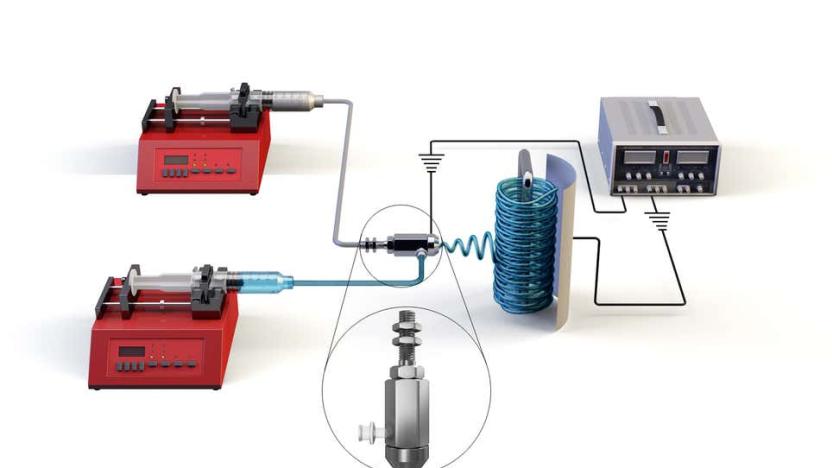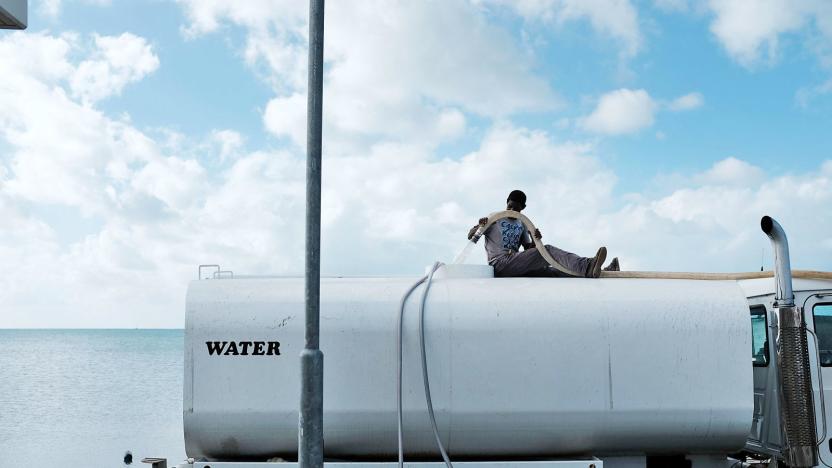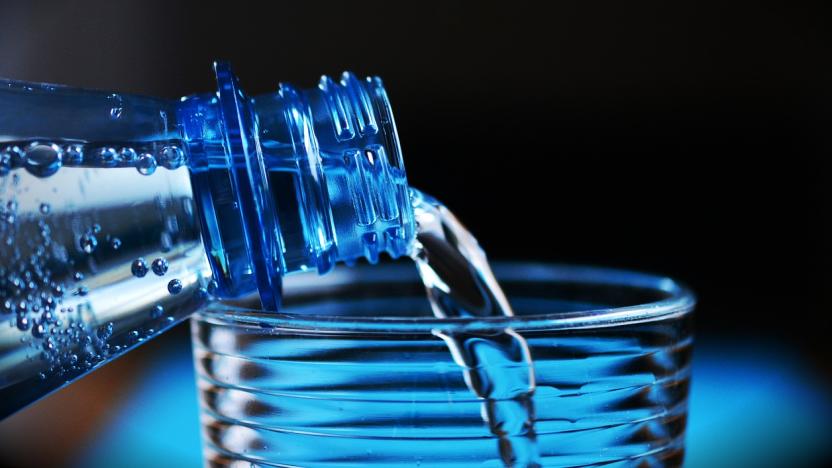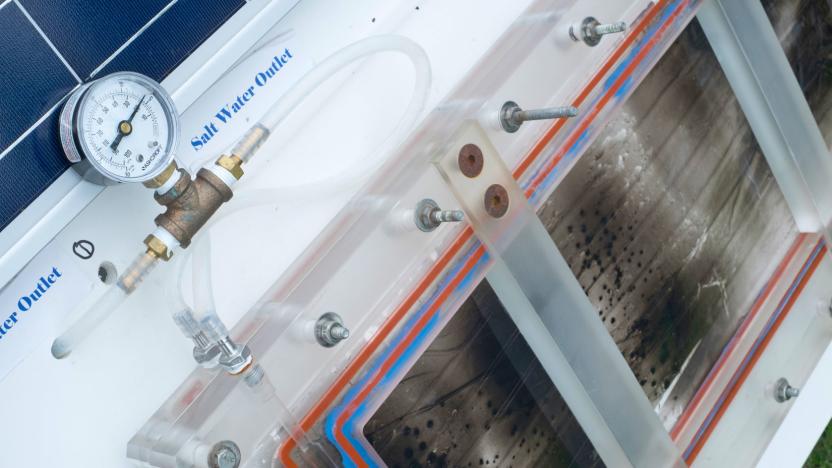desalination
Latest

A nanofiber membrane could help solve the drinking water crisis
Researchers from the Korea Institute of Civil Engineering and Building Technology have created a nanofiber membrane that can desalinate water for up to a month.

Water purification could be the key to more electric cars
Humanity is going to need a lot of lithium batteries if electric cars are going to take over, and that's a problem when there's only so much lithium available from conventional mines. There may be an oddball solution for that, however: turn the world's oceans into eco-friendly mines. Scientists have outlined a desalination technique that would use metal-organic frameworks (sponge-like structures with very high surface areas) with sub-nanometer pores to catch lithium ions while purifying ocean water. The approach mimics the tendency of cell membranes to selectively dehydrate and carry ions, leaving the lithium behind while producing water you can drink.

Scientists use molecular 'sieve' to purify water
Researchers have taken a major step forward in making previously undrinkable water drinkable, therefore tackling one of the biggest challenges faced by the planet -- some 1.2 billion people lack access to clean drinking water (a number which is set to grow as populations increase). By modifying graphene oxide membranes, the international team of researchers has created what is essentially a molecular "sieve". The selectively permeable membrane lets some molecules through while trapping others behind, producing water at various levels of cleanliness suitable for drinking or for industrial applications.

Researchers can now desalinate seawater with the power of the Sun
One of the oldest means of extracting potable liquid from seawater involves distillation, basically boiling the water into steam and then cooling the purified vapor in condensation tubes. Problem is, this method is incredibly power intensive with nearly half of the input energy going towards just boiling the water. But, a team of researchers from Rice University have developed a new technique that not only drastically reduces the amount of energy needed but can decouple the process from the power grid altogether.

ICYMI: Real-time drawing collaboration and sippable seawater
try{document.getElementById("aol-cms-player-1").style.display="none";}catch(e){}Today on In Case You Missed It: Google introduced a new cloud-connected whiteboard called the Jamboard, which is made for collaboration with coworkers, then the finished doodle can be stored in Google Drive. Meanwhile the SAROS is a wave-powered desalination system that can produce 3,500 gallons a water a day of potable water from seawater, up on Kickstarter with the aim of helping coastal communities get better access to drinking water. Finally anyone prepping for Halloween will have carving envy from this video. The Pizza Hut video is here. As always, please share any interesting tech or science videos you find by using the #ICYMI hashtag on Twitter for @mskerryd.

Six technologies that produce clean, safe drinking water
By Cat DiStasio One in 10 people worldwide lack regular access to safe drinking water. In an effort to tackle this most basic humanitarian problem, engineers around the globe have developed a wide array of devices, large and small, that generate clean water. Each year, a slew of innovations aim to make the process easier, cheaper and more portable, as well as produce a yield high enough to make a real impact for some of the 663 million people who suffer from water shortages. Solutions range from using condensation methods to pull water from thin air, turning salty seawater into fresh water, or distributing UV light purification chips affordable enough for people to use at home. Only a few of these technologies are working outside the lab, but the ones that do have so far generated billions of gallons of clean water.

6 gadgets that provide fresh water to those who need it most
By Cat DiStasio There are 1.2 billion people around the world do not have reliable access to fresh, potable water. That's why advancements in water purification technology are so important. Fortunately, there are a lot of innovative folks working on creative ways to solve water-scarcity issues by developing new techniques, maximizing efficiency and sometimes even producing drinking water from thin air. Read on for six of the world's most innovative water generators, from machines that collect H2O in the middle of the desert to a bike-mounted contraption that harnesses solar energy to collect water from the air as you ride.

Inhabitat's Week in Green: rocket fuel, recycled jeans, and the electric eel powered Christmas tree
Each week our friends at Inhabitat recap the week's most interesting green developments and clean tech news for us -- it's the Week in Green. Eco transportation took off this week as researchers in Sweden discovered a new molecule that could make rocket fuel 30 percent more efficient. We also caught up with Russia's plans to construct a new high-speed rail system for the 2018 World Cup, and we saw several major auto manufacturers give their vehicles green upgrades - Ford announced it will insulate its 2010 Focus with recycled jeans, and Chevrolet launched plans to transform 100,000 pounds of used oil booms into parts for the Volt. The past week also saw bright horizons dawn for renewable energy as the world's largest parabolic trough solar plant received a $1.5 billion DOE loan. The world of consumer tech was energized by the sun's rays as Toshiba unveiled a new solar-powered e-book reader and one designer developed a solar-powered desalination system that could keep shipwrecked survivors alive at sea. We also brought you artist Michael McKean's plan to shoot rainbows across the sky at will with his solar-powered rainbow generator. Speaking of spreading renewable cheer, this month Japan's Enoshima Aquarium unveiled the world's first Christmas tree powered by an electric eel. The FAA also got into the holiday spirit as they approved a next-gen Santa sleigh that delivers gifts 53% faster, and if you unwrapped a new video game system this year, you may be interested to know that the Nintendo Wii was recently crowned the most energy-efficient next-gen gaming console. Finally, if the wintry weather has you feeling down, just take a peek inside this supermassive airship hangar, transformed into a year-round tropical island getaway.

Inhabitat's Week In Green: solar panels, solar planes, solar trains
The Week in Green is a new item from our friends at Inhabitat, recapping the week's most interesting green developments and clean tech news for us. It was an interesting week in green tech, as Inhabitat explored the past and future of solar technology. We dug up the world's first modern solar panel (still working after 60 years!) and wrapped our brains around MIT's plan to create super-efficient photovoltaic panels by folding them up like origami. Not to be outdone, IBM unveiled plans to roll out a new solar desalination system that could transform entire expanses of desert into rivers. Solar power also took to the skies this week as the Solar Impulse plane made its first successful flight. And speaking of futuristic transportation, Minority Report-style podcars may be just around the corner if this solar powered urban transit system takes off. We were wowed by Finland's new all-electric supercar, which will be vying for the Progressive Auto X Prize this summer. We also took a look at several innovative kid-friendly designs including an incredible Game Boy made from paper and a biometric baby monitoring alarm clock that lets parents monitor their babies' temperature and heart-rate remotely, as well as cue up lullabies from anywhere. The past week also produced several promising developments from the realm of energy storage as Hitachi announced that it's developing lithium-ion batteries that last twice as long. And finally, meet BOB, a battery the size of a building that is capable of powering an entire town in Texas. The gigantic sodium sulfur backup battery can store up to 4 megawatts of power for up to 8 hours.

Wave-powered Edinburgh Duck desalinates seawater
Sure, in theory we could use the LifeStraw to purify enough water to quench the thirst of thousands of people, and if Aqua Sciences proves successful in its endeavor to pull water out of thin air, desalinating the seas could prove unnecessary. Nevertheless, Stephen Salter at Edinburgh University in the UK is working with a research team to perfect the "Edinburgh Duck" and provide useful water for needy individuals. The desalinating critters convert wave energy into pressure changes that aid the collection of pure water (in the form of steam) from seawater; by lowering air pressure, the system can draw steam from water at lower temperatures. The pressure-driven machines operates sans electricity by using the crashing motion of waves to operate its innards in a "piston-like motion," slowly but surely creating salt-free water that's pumped back ashore through the two legs that tether the duck to the seabed. Although current prototypes are only pumping air, finalized units could be 10 meters in diameter and 20 meters long -- a device large enough to supply water for "more than 20,000 people." While we're sure the targeted audience here is arid countries with good access to seawater, those days at the beach would be much more enjoyable without generous helpings of NaCl finding their way into our mouths.[Via Slashdot]






